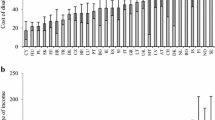Abstract
We describe the degree to which household income is negatively associated with the prevalence of different types of disability (i.e., medical impairments) in China using data from the 2006 Second National Survey of Disabled Persons. We then calculate the extra costs of disability across different types of households and show how these costs differ by the type and severity of disability in both urban and rural areas. Finally, we use nationally representative panel data on persons with disabilities from 2007 to 2009 to examine the degree to which social security is reaching persons with different types and severity of disabilities in both urban and rural areas. We conclude that although the amount and coverage of social security for households with disabilities is increasing rapidly, it is still not enough to offset the income differential between households with and without disabled persons, especially when we account for the extra costs of disability.


Similar content being viewed by others
References
Berthoud, R., Lakey, J., & McKay, S. (1993). The economic problems of disabled people. London, UK: Policy Studies Institute.
Braithwaite, J., & Mont, D. (2009). Disability and poverty: A survey of World Bank poverty assessments and implications. ALTER-European Journal of Disability Research, 3, 219–232.
Case, A., & Paxson, C. (2010). Causes and consequences of early-life health. Demography, 47, S65–S85.
Chen, S. H., & Ravillion, M. (2008). China is poorer than we thought, but no less successful in the fight against poverty (WPS No. 4621). Washington, DC: World Bank.
Cullinan, J., Gannon, B., & Lyons, S. (2008). Estimating the economic cost of disability in Ireland (ESRI Working Paper No. 230). Dublin, Ireland: The Economic and Social Research Institute.
Cullinan, J., Gannon, B., & Lyons, S. (2011). Estimating the extra cost of living for people with disabilities. Health Economics, 20, 582–599.
Cullinan, J., Gannon, B., & O’Shea, E. (2013). The welfare implications of disability for older people in Ireland. European Journal of Health Economics, 14, 171–183.
Elwan, A. (1999). Poverty and disability: A survey of the literature. Washington, DC: Social Protection Advisory Service, World Bank.
Haveman, R., & Wolfe, B. (2000). The economics of disability and disability policy. In A. J. Culyer & J. P. Newhouse (Eds.), Handbook of health economics (Vol. 1, pp. 995–1051). New York, NY: Elsevier/North-Holland.
Hoogeveen, J. G. (2005). Measuring welfare for small but vulnerable groups: Poverty and disability in Uganda. Journal of African Economies, 14, 603–631.
Kolenikov, S., & Angeles, G. (2009). Socioeconomic status measurement with discrete proxy variables: Is principal component analysis a reliable answer? Review of Income and Wealth, 55, 128–165.
McKenzie, D. J. (2005). Measuring inequality with asset indicators. Journal of Population Economics, 18, 229–260.
Metts, R. (2000). Disability issues, trends and recommendations for the World Bank [full text and annexes]. Washington, DC: World Bank.
Metts, R. (2004). Disability and development (Background paper prepared for the Disability and Development Research Agenda Meeting, November 16, 2004). Washington, DC: World Bank.
Ministry of Civil Affairs, China. (2010). China Civil Affairs Development Statistical Bulletins.
Mitra, S. (2005). Disability and social security nets in developing countries (World Bank Social Protection Discussion Paper No. 0509). Washington, DC: World Bank.
Mont, D. (2007). Measuring disability prevalence (SP Discussion Paper No. 0706). Washington, DC: World Bank.
Mont, D., & Cuong, N. V. (2011). Disability and poverty in Vietnam. The World Bank Economic Review, 25, 323–359.
Murray, C., & Chen, L. (1992). Understanding morbidity change. The Population and Development Review, 18, 481–503.
National Bureau of Statistics. (2009). China statistical yearbook. Beijing: China Statistics Press.
O’Keefe, P. (2007). People with disabilities from India: From commitments to outcomes. Washington, DC: World Bank. Retrieved from http://documents.worldbank.org/curated/en/2007/05/8746167/people-disabilities-india-commitments-outcomes
O’Reilly, A. (2007). The right to decent work of persons with disabilities. Geneva, Switzerland: ILO.
Saunders, P. (2007). The costs of disability and the incidence of poverty. Australian Journal of Social Issues, 42, 461–480.
Scott, K., & Mete, C. (2008). Measurement of disability and linkages with welfare, employment, and schooling. In C. Mete (Ed.), Economic implications of chronic illnesses and disability in Eastern Europe and the former Soviet Union (pp. 35–66). Washington, DC: World Bank.
Sen, A. (2004). Disability and justice. In Disability and Inclusive Development Conference, keynote speech. Washington, DC: World Bank.
Stern, S. (1989). Measuring the effect of disability on labor force participation. Journal of Human Resources, 24, 361–395.
World Health Organization (WHO). (2001). International classification of functioning, disability and health. Geneva, Switzerland: WHO.
Zaidi, A., & Burchardt, T. (2005). Comparing incomes when needs differ: Equivalization for the extra costs of disability. Review of Income and Wealth, 51, 89–114.
Zheng, X., Chen, G., Song, X., Liu, J., Yan, L., Du, W., . . . Zhang, J. (2011). Twenty-year trends in the prevalence of disability in China. Bulletin of the World Health Organization, 89, 788–797.
Zhu, Y. K. (2009). A case study on social security extension in China (Working Paper No. 7). Geneva, Switzerland: International Social Security Association.
Author information
Authors and Affiliations
Corresponding author
Rights and permissions
About this article
Cite this article
Loyalka, P., Liu, L., Chen, G. et al. The Cost of Disability in China. Demography 51, 97–118 (2014). https://doi.org/10.1007/s13524-013-0272-7
Published:
Issue Date:
DOI: https://doi.org/10.1007/s13524-013-0272-7




